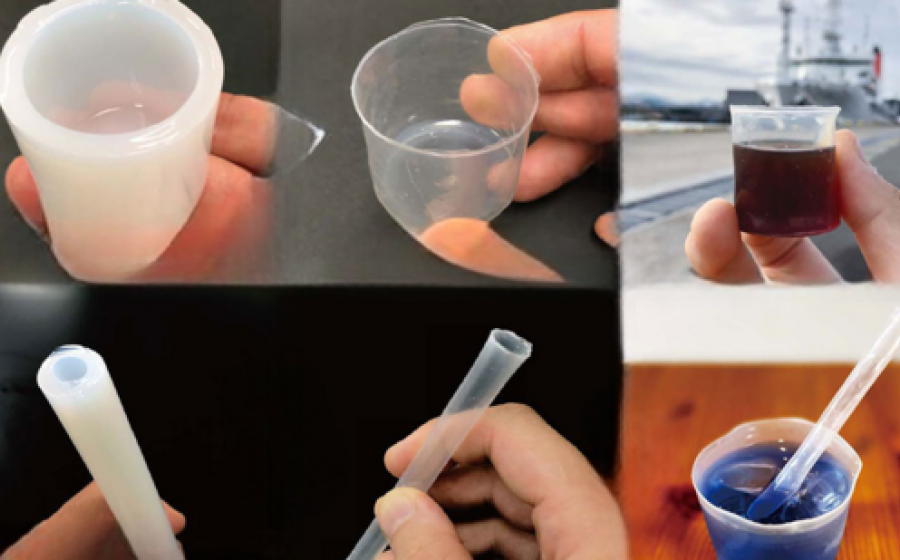
The team of scientists announced that the paper is so clear that juice and other drinks in cartons made from the novel material will be visible from the outside.
Derived from plants, the material is decomposable by microorganisms and is thereby expected to be a substitute for plastic containers at some point.
The see-through paper is flexible and bends easily. Its durability, even when wet, allows the material to be processed into a range of shapes, inclusive of cups and straws.
The team of scientists who accomplished the feat hail from research institutes including the Japan Agency for Marine-Earth Science and Technology (JAMSTEC), headquartered in Yokosuka, Kanagawa Prefecture.
Their findings were published in the U.S. academic journal Science Advances at (https://www.science.org/doi/10.1126/sciadv.ads2426) on April 10.
Noriyuki Isobe, a sub-chief researcher at the JAMSTEC, who headed the research team, expressed high expectations.
“I expect the material to be a trump card in the fight against marine pollution,” he said.
The project started when Isobe, who had been involved in studies on cellulose, the main component of wood and paper, joined the JAMSTEC in 2017.
He then saw firsthand how severely contaminated the deep ocean waters were by piles of disposable plastics, because the JAMSTEC has a substantial database of images recorded by research submersibles.
Seeing plastic bags, among various pollutants, scattered across the seabed at a depth of more than 1,000 meters, Isobe quickly thought of replacing plastic containers with those fashioned from a material that could be decomposed by microorganisms even in the ocean.
Paper in particular seemed to be one of the promising substances for Isobe.
But the material had a serious weakness. Since paper is manufactured with wood-mashed pulp, the gaps between its thick fibers diffuse light and make the finished sheets opaque.
This is especially problematic given that transparency is highly valued in the food industry. Packages that allow consumers to check the contents beforehand are thought to motivate shoppers to select certain products.
In France, a food maker once rolled out paper cartons for a juice beverage but later reportedly reverted to plastic containers in at least one instance.
Deriving from cellulose-like paper, the material called cellophane was already known for its see-through appearance.
A challenge is that cellophane is as thin as 0.03 millimeter under current production methods. It has long been thought of as technically impossible to produce cellophane between 0.3 mm and 0.7 mm--thick enough for use in paper cartons and other commercial packaging.
Taking this into account, Isobe hit upon the method of relying on a lithium bromide water solution. As an academic colleague of his was researching the liquid, the chemical agent’s ability to dissolve silk and cellulose was starting to draw attention around that time.
Isobe conceived of a plan to dissolve and solidify cellulose by adjusting the temperature of the aqueous solution, so that the perfected paper’s thickness and shape could be freely fine-tuned.
The following year in 2018, he began working on developing a prototype. Isobe solidified, washed and dried cellulose, successfully crafting a super clear yet significantly thick sheet of paper.
Fibers were finely broken down into molecules in the process reportedly to produce a dense structure with no openings, which enabled, in turn, light to pass through without being scattered.
Another unique point of the research project this time was that the team verified whether it “can be actually decomposed in the deep sea” while taking full advantage of the JAMSTEC’s facilities and expertise.
With the help of the manned research submersible Shinkai 6500 and other equipment, cups featuring the new material were placed on oceanic floors.
These locations included the 757-meter-deep area off the Misaki district in Kanagawa Prefecture along Sagami Bay and a location 5,552 meters below the surface near Japan's easternmost island of Minami-Torishima in the Pacific.
Filming the containers for six months revealed that they gradually disintegrated. A cup off Misaki ended up disappearing within four months.
Hopes are growing for the specialized paper’s future commercial application. However, a hurdle that remains is its high cost.
It is extremely difficult for the paper material to quickly become as affordable as reasonable plastics mass-produced from oil, as the one-of-a-kind substance can only be crafted in a dedicated lab as of now.
Due to this obstacle, Isobe and his colleagues are racking their brains with the aim of getting major manufacturers interested in their research.
The scientists intend to propose a cheaper production technique similar to that utilized for making paper cartons and other common types of cardboard. They are also looking to suggest a special manufacturing line to rein in energy consumption.
“I envision a society where everything we need in our daily lives comes exclusively from substances generated by living organisms,” Isobe said. “Daily items should be carefully reused over and over at the same time.”



